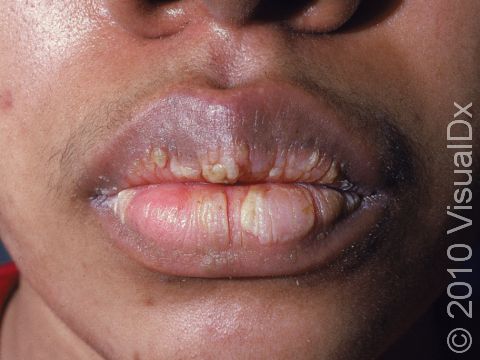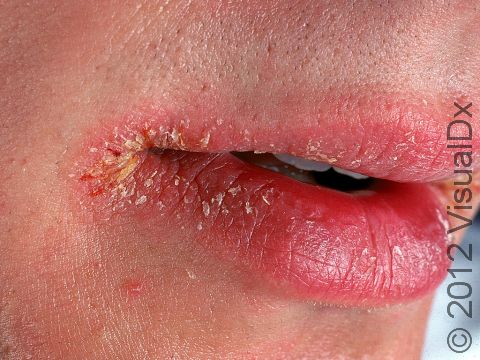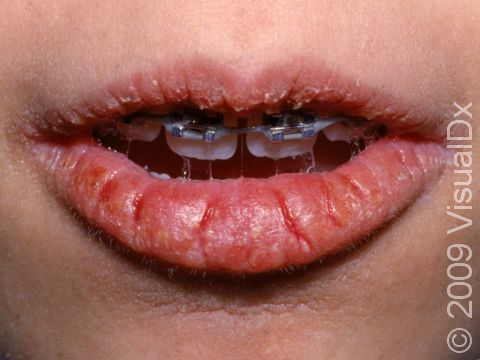Chapped Lips (Cheilitis)
Cheilitis, commonly known as chapped lips, involves lips that appear dry, scaly, and may have one or more small cracks (fissures). Often, the lips are sensitive, and there may be redness and swelling.
Chapped lips are commonly caused when people lick their lips repetitively. Chapped lips may be caused by a reaction of the skin to products such as certain cosmetics, lip balms, toothpastes, and sunscreens. A rarer cause of chapped lips is infection with yeast called Candida albicans coupled with chronic lip licking. Retinoids (eg, isotretinoin and acitretin) are the most frequent medication-induced cause of chapped lips. Other medications known to cause chapped lips include:
- High doses of vitamin A.
- Lithium.
- Chemotherapeutic agents (busulfan and actinomycin).
- D-penicillamine.
- Isoniazid.
- Phenothiazine.
Other possible causes of chapped lips are high fevers as well as environmental conditions, such as cold weather, dehydration, and certain vitamin deficiencies.
Who's At Risk?
Chapped lips may be seen in people of all ages. However, chapped lips caused by lip licking is most commonly seen in children aged 7-15 years.
Signs & Symptoms
Chapped lips are dry and scaly and may have small cracks. There may also be a pink, scaly ring around the mouth and mild-to-moderate swelling of the lips. In darker skin colors, the ring around the lips may appear brown.
Self-Care Guidelines
Avoid lip licking because that will only worsen the condition.
Avoid “medicated” lip products because they increase your risk of developing an allergic reaction, making the chapped lips worse. If a personal care product is thought to be the cause, try using a different product.
If you suspect a medication is causing your chapped lips, do not discontinue the medication without first talking to a medical professional.
Moisturize the lips frequently with petroleum jelly (Vaseline) as needed.
Treatments
The medical professional will first want to determine the cause of the chapped lips.
Chapped lips caused by lip licking are best treated with avoidance of the lip licking, which your medical professional will likely emphasize. For chapped lips caused by a medication, your medical professional can advise on whether you can stop the medication or substitute another.
If the chapped lips are caused by yeast, the medical professional will prescribe a topical antifungal such as nystatin, clotrimazole, or econazole.
Visit Urgency
See your medical professional if you notice persistent scaling of the lips.
References
Bolognia J, Schaffer JV, Cerroni L. Dermatology. 4th ed. Philadelphia, PA: Elsevier; 2018.
James WD, Elston D, Treat JR, Rosenbach MA. Andrew’s Diseases of the Skin. 13th ed. Philadelphia, PA: Elsevier; 2019.
Kang S, Amagai M, Bruckner AL, et al. Fitzpatrick’s Dermatology. 9th ed. New York, NY: McGraw-Hill Education; 2019.
Paller A, Mancini A. Paller and Mancini: Hurwitz Clinical Pediatric Dermatology. 6th ed. St. Louis, MO: Elsevier; 2022.
Last modified on June 17th, 2024 at 10:16 am

Not sure what to look for?
Try our new Rash and Skin Condition Finder



